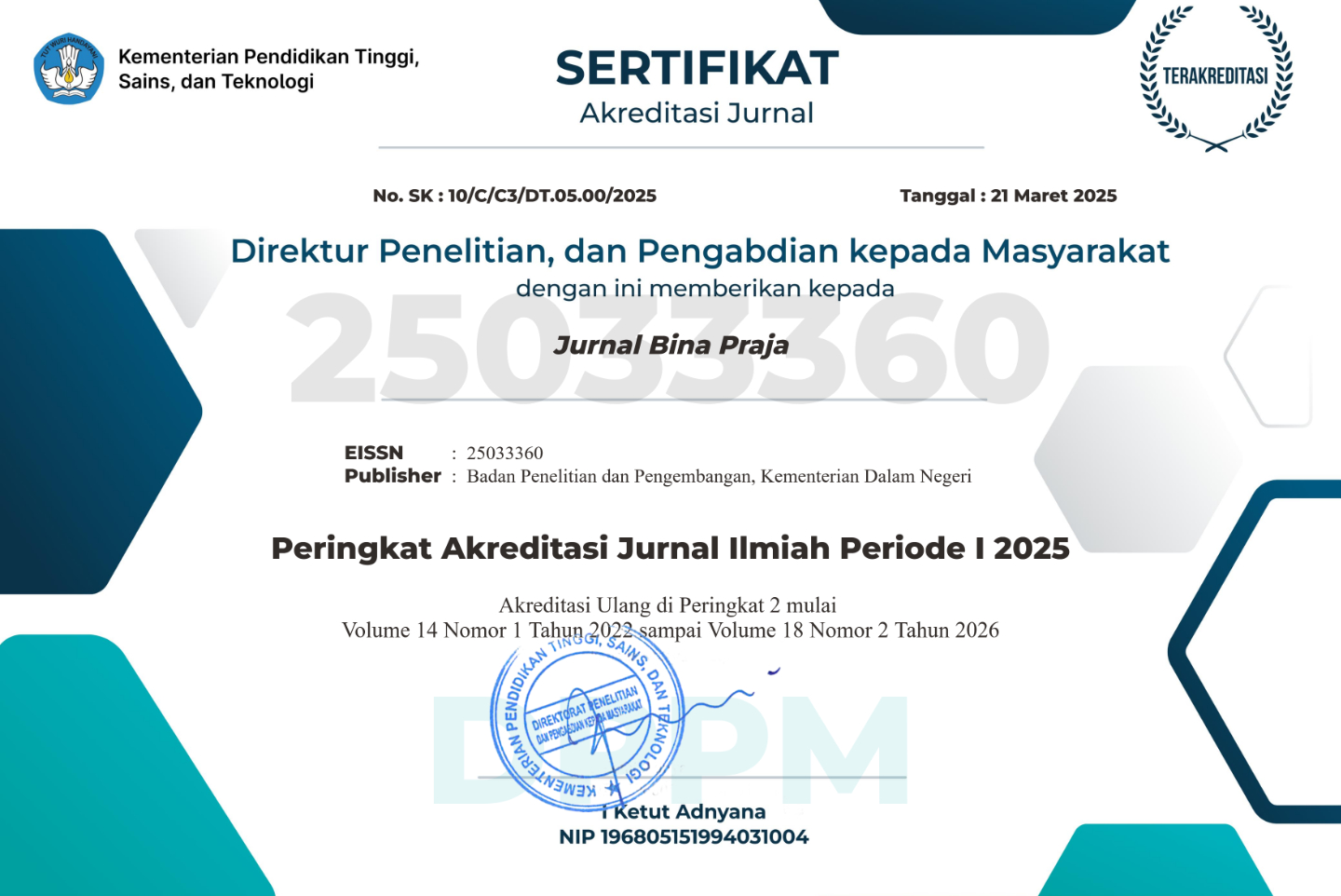Evaluation of the Asset Manager Paradigm in the Management of Regional Property (BMD)
A Study of the Regional Government of Yogyakarta Special Region (DIY)
DOI:
https://doi.org/10.21787/jbp.17.2025.89-102Keywords:
Asset Manager Paradigm, Management of Regional Asset, Measurement Model, Asset Manager Paradigm Successful IndexAbstract
The government is actively campaigning for the asset manager paradigm as a new approach to realizing more effective and efficient asset management. However, until now, local governments are still struggling to evaluate the success of the asset manager paradigm due to the lack of adequate measurement instruments. This research aims to evaluate the success of the asset manager paradigm in managing Regional Property (BMD). Evaluation of the success of the manager asset paradigm can be carried out using the asset manager paradigm success index model, which is a composite index of success indicators in activity dimensions that require an asset manager paradigm perspective. These activities include planning needs and budget, use, utilization, as well as security and maintenance. The data used in this research is secondary data in the form of Financial Reports from the DIY Regional Government. This data is used to measure the success of the asset manager paradigm with relevant indicators and formulas. The evaluation results showed a decrease in the average value of the three-dimensional indicators measured and an increase in one other dimensional indicator. The evaluation results also showed that there was still room for Regional Apparatus Organizations (OPD) within the DIY Regional Government to increase the spirit of the asset manager paradigm in BMD management. This research produces a measurement model that can be used by local governments to evaluate the success of the asset manager paradigm in managing BMD. This measurement model can be a reference in developing a more comprehensive asset manager paradigm success measurement model in the future.
Downloads
References
Anartany, S., & Suseno, D. (2018). Strategi Optimalisasi Aset Idle Daerah Provinsi Jawa Tengah. Economics Development Analysis Journal, 7(1). https://doi.org/10.15294/edaj.v7i1.21923
Bahri, S. (2017). Pengembangan kurikulum dasar dan tujuannya. Jurnal Ilmiah Islam Futura, 11((1)), 15–34.
Bappeda. (2024). Rapat Koordinasi Pengendalian TW III - Optimalisasi Aset DIY Sebagai Potensi Sumber Pendapatan Asli Daerah. Https://Bapperida.Jogjaprov.Go.Id/Berita/Detail/Rapat-Koordinasi-Pengendalian-Tw-Iii-Optimalisasi-Aset-Diy-Sebagai-Potensi-Sumber-Pendapatan-Asli-Daerah
Cornish, N., & Morton, K. (2001). Asset governance—a radically new way to manage distribution networks in a competitive and deregulated market. 16th International Conference and Exhibition on Electricity Distribution (CIRED 2001).
DPLG. (2010). Guidelines for Infrastructure Asset Management in Local Government 2006-2009.
Foster, J. (2001). Data Analysis Using SPSS for Window Version 8 to 10. SAGE Publications, Ltd. https://doi.org/10.4135/9781849208796
Ghozali, I. (2018). Aplikasi Analisis Multivariate Dengan Program IBM SPSS. Badan Penerbit Universitas Diponegoro.
Hadiyanto. (2009). Strategic Asset Management: Kontribusi Pengelolaan Aset Negara dalam Mewujudkan APBN yang Efektif dan Optimal (A. Abimanyu & A. Megantara, Eds.). PT Kompas Media Nusantara, Jakarta.
Hadiyanto. (2014). Sederhanakan Birokrasi Pengelolaan BMN. Https://Www.Djkn.Kemenkeu.Go.Id/Berita/Baca/5442/PP-272014-Sederhanakan-Birokrasi-Pengelolaan-BMN.Html#:~:Text=Jakarta%20%E2%80%93%20Untuk%20menyamakan%20persepsi%20baik%20di,Sebagai%20pengganti%20PP%20Nomor%206%20Tahun%202006%2C
Hair, J., Black, W., Babin, B., Anderson, R., & Tatham, R. (2006). Multivariate Data Analysis. Prentice Hall.
Hajar, B. (2015). Bureaucracy and Governance in Indonesia: Study on West Sulawesi Province. Procedia Economics and Finance, 23, 223–227. https://doi.org/10.1016/S2212-5671(15)00348-2
Humphrey, B. (2003). Asset Management, in Theory and Practice. Energy pulse: insight, analysis and commentary on the global power industry.
Judd, C., & McClelland, G. (1989). Data analysis: A model Comparison approach. Harcourt Brace Jovanovich.
Kaganova, O., & Amoils, J. M. (2020). Central government property asset management: a review of international changes. Journal of Corporate Real Estate, 22(3), 239–260. https://doi.org/10.1108/JCRE-09-2019-0038
Komonen, K., Kortelainen, H., & Räikkönen, M. (2006). An asset management framework to improve longer term returns on investments in the capital-intensive industries. In WCEAN, Queensland.
Lu, Y. (2017). Public capital asset management:A holistic perspective. Journal of Public Procurement, 17(4), 483–524. https://doi.org/10.1108/JOPP-17-04-2017-B002
Mardiasmo, D. (2012). State asset management reform in Indonesia: a wicked problem. Queensland University of Technology.
Mardiasmo, D., & Liyanage, J. (2015). Asset Management Reform Through Policies, Regulations, and Standards: The Need for ‘Soft’ Interface (pp. 1189–1198). https://doi.org/10.1007/978-3-319-09507-3_100
Mardiasmo, D., & Sampford, C. (2015). Is Good Governance Conceptualised in Indonesia’s State Asset Management Laws? (pp. 1157–1171). https://doi.org/10.1007/978-3-319-09507-3_98
Mardiasmo, D., Sampford, C., & Barnes, P. (2012). The Exemplification of Governance Principles within State Asset Management Laws and Policies: The Case of Indonesia. In Engineering Asset Management and Infrastructure Sustainability (pp. 613–631). Springer London. https://doi.org/10.1007/978-0-85729-493-7_48
Ngwira, M., Parsa, A., & Manase, D. (2012). Effectiveness of property asset management in Scottish councils. Journal of Corporate Real Estate, 14(2), 105–120. https://doi.org/10.1108/14630011211261704
Noviyati, A. M., & Khoirudin, R. (2023). Analisis Optimalisasi Aset Pemerintah Daerah di Daerah Istimewa Yogyakarta. Journal of Economics, Assets, and Evaluation, 1(2), 1–11. https://doi.org/10.47134/jeae.v1i2.115
Pudjiastuti, C. (2015). Perubahan Paradigma Manajer Aset. Media Kekayaan Negara: Sewindu Pengabdian Pengelolaan Kekayaan Negara.
Saunders, M., Lewis, P., & Thornhill, A. (2009). Research Method for Business Students. Prentice Hall.
Tirayoh, V. Z., Latjandu, L. D., Sabijono, H., & Mintardjo, C. M. O. (2021). Public Sector Asset Management in the Government of Indonesia: A Case Study in Minahasa Regency. Jurnal Bina Praja, 13(2), 195–205. https://doi.org/10.21787/jbp.13.2021.195-205
Too, E. G. (2012). Strategic Infrastructure Asset Management: The Way Forward. In Engineering Asset Management and Infrastructure Sustainability (pp. 945–958). Springer London. https://doi.org/10.1007/978-0-85729-493-7_73
Wahyudi, A. (2016). Value-added in Public Service Innovation: The Practice at Integrated Service Units in Pontianak Municipality and Tanah Bumbu District. Jurnal Bina Praja, 08(01), 49–58. https://doi.org/10.21787/JBP.08.2016.49-58
Wargadinata, E. L., & Tendean, N. R. P. (2024). Amidst the Euphoria of Digitalization Public Services in Municipal Government: Raising Public Acceptance. Jurnal Bina Praja, 16(2), 335–346. https://doi.org/10.21787/jbp.16.2024.335-346
Woodhouse, J. (2004). Asset Management Decision-making. Strategic Infrastructure Asset Management.
Yusof, Y. (2013). The Effectiveness of Public Sector Asset Management in Malaysia. Queensland University of Technology.
Zakaria, R. (2024). The Implementation of Good Governance in Fixed Assets Management. International Journal for Multidisciplinary Research, 6(1).
Downloads
Published
How to Cite
Issue
Section
License
Copyright (c) 2025 Author(s)

This work is licensed under a Creative Commons Attribution-NonCommercial-ShareAlike 4.0 International License.















